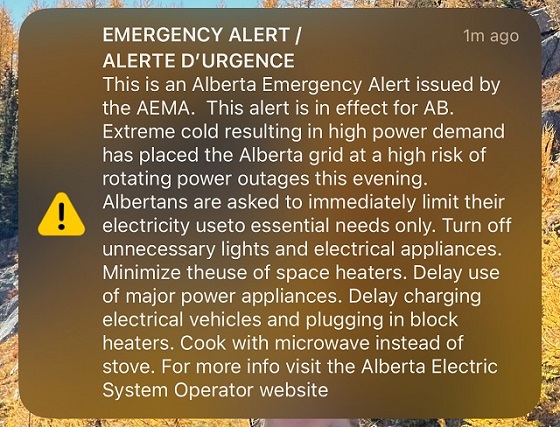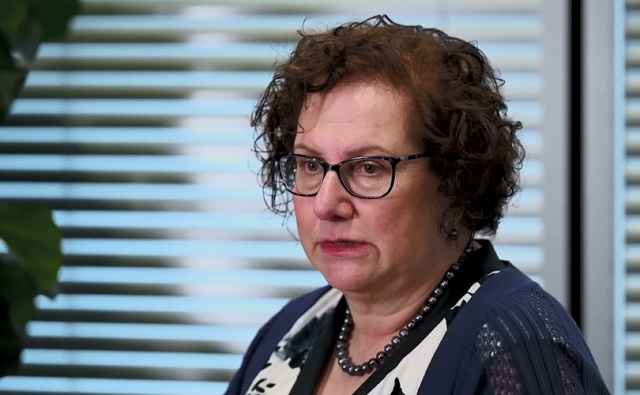Energy
No calling in sick or waiting for a nice day – The grid has to perform on the worst of them

From the Frontier Centre for Public Policy
By Terry Etam
Saturday night, the middle of the cold snap, was something to be endured
Saturday night, the middle of the cold snap, was something to be endured. Things break at -36 degrees. A quick run to the grocery store was rerouted by a fleet of city vehicles tearing up the street in a considerable manner, most likely chasing a broken water main or some such. Imagine being without water on a night like that.
Half an hour later it got worse – the provincial grid operator issued an alert for people to “immediately limit their electrical use to essential needs only.”
Keep in mind the staggering circumstance, and location, of that alert: Alberta. Even the province’s biggest naysayer would have to admit that the province is an energy juggernaut, blessed with resources most of the world can only dream of, including and especially energy.
If power consumption levels were not reduced, there could have been rolling blackouts. Anyone care to imagine what that would have been like at -35 degree temperatures?
Hopefully every single voter in Canada, and the US for that matter, is paying attention. The false prophecies of utopian energy transitions visions are, quite clearly, dangerously false.
The media feeds you dumbed-down pablum; don’t take it at face value. Instead of listening to blathering about “new installed capacity”, pay attention to actual output. In extreme cold, wind and solar output fall to zero, or very close. It doesn’t matter if there are a billion gigawatts of ‘capacity’ installed.
Everyone needs to understand the fundamental issue that was best described by Nassim Taleb via his turkey analogy. A turkey has 364 days of a very good life, followed by one very bad day come Thanksgiving. It is the bad day that matters, not 364 good ones. A deadly day is a deadly day.
It’s the same with renewables penetration, and how it makes the news ‘on the good days’. Activists and simplistic policymakers (but I repeat myself) tout how a particular jurisdiction may have at such and such a time sourced “xx percent” of power from renewables. Yay, look at the progress, marching ever higher. But it’s not what it sounds like. It doesn’t matter if a country or state or province gets 80% of its power from solar at the peak of a good sunny day, nor if 80% comes from wind on a particularly windy day. Those are misleading numbers, because the system must be fully capable of meeting peak demand every day, and not just ‘on a good day’.
According to AESO, the provincial grid operator, Alberta has 4,481 MW of wind power capacity. At the peak of last weekend’s deepfreeze, it was producing about 1/3 of one percent of that total. Not just useless, but far worse: useless when needed exactly the most.
What matters is: how does the system perform at peak times – what is going to show up on demand?
Just like everyone else that’s trying to bring rationality to this conversation, I need also point out that wind and solar are welcome additions, in moderate amounts, sited where they do the least damage, and as supplements to a grid.
But that’s where the conversation needs to get serious. The real danger out there are people that want an energy transition so badly, or are employed as ‘climate architects’ such that their career depends on it, who sweep some mighty big things under the rug.
“We just need more storage, then wind and solar will be able to carry the load.” Not possible, not if batteries are the vision. Imagine a day’s worth of battery power supply for the entire province. Or two days. The cost would be off the charts, and, then after two days of ‘usage’, how would the batteries get recharged if the cold spell persisted more than a few days? Is that the kind of backup anyone would accept? We’ll have power again if the wind picks up strongly and consistently for the next week, if not, well, good luck?
“Sure we can handle an all-EV world because users can charge at night.” I’ve seen this argument now and then, based on some simplistic studies that show, correctly, that financial enticements can get people to charge EVs at off peak hours. But that’s a red herring in the world we are headed for, “electrify everything”. If we do electrify even half of what we could, then peak demand will still go way up, as will our life-perched dependency on it. More EVs just mean more load. And not all EVs will shift to night charging; it is some pretty weak thinking to imagine that all EV owners will have that optionality, or live in a place that allows it, or won’t be travelling, etc. And remember that the feds’ plan is for all vehicles to be electrified. So maybe J. Consumer in suburbia can shift his EV to night charging, but what about a fleet of city buses, or Uber drivers, or forklifts, or taxis, or…the list is endless.
“We can switch to heat pumps.” This one takes the cake. Heat pumps will exacerbate the problem at the exact worst time – when it is coldest, and when power demand is highest, and when the grid is maxed out. It is the opposite of proponents who say EVs can charge at off peak hours – heat pumps will be called into full service precisely at peak hours. Taleb’s turkey again: a mass-heat-pump system will be wonderful on many days, but on the very worst day, all goes black. And cold.
There is no joy in this silly debate we seem to be in with ideologues, particularly when the threat of rolling blackouts is announced by the grid operator. But there is also no time to waste indulging people who want to rewire the grid with “well academic studies say this should work.” Set up your own commune somewhere and experiment for a few years and at least one winter cold snap, then let us know how it goes.
Wishful thinking doesn’t turn many wrenches, nor does it heat homes. Wishful thinking is not what an energy system can or should be built on. Energy is life or death in extreme weather. Ideology is the last thing that should be involved in energy supply, and yet we are up to our ears in it, a situation that is becoming dangerous.
People can see this. They may not understand how grids (and energy) work, but they know when something smells bad. That’s why federal government support is at such lows, and why distrust in the media is at such highs. Political scientists telling you “Don’t worry, we know how to design a new grid” are no match for the likes of, for example, real-world experiences such as this relayed by a gentleman named John Wright on LinkedIn: “Currently out at our cabin trying to help out our heat pumps (we run three geothermal units and they are running full out with auxiliary/ supplemental heating coils engaged). We have two propane fireplaces burning full time in addition to all the firewood that we’re also splitting and burning, and all of the burners on the cooktop are on. It’s probably about +12.5° C inside here vs -36°C outside…Everyone seems to ignore the fact that heat pumps are a huge draw on the power grid. Our power bill could easily be $1500.00 to $2000.00 for January…By the way, the power consumption and poor performance is the same in the summer when it is +36°C here.”
And finally, it is important to note that the gradual but persistent undermining of the hydrocarbon industry will have massive consequences, because hydrocarbons underpin everything we use and do. Governmental and media animosity will drive away capital (don’t wonder why dividends are such a popular thing in the oil and gas sector – capital flight in full view) and ultimately weaken a pillar of our economy. Until nuclear energy is ubiquitous, or some technological breakthrough happens, we need reliable, baseload power, which at this time in history means hydrocarbons, here and around the world. That baseload is not guaranteed, it is not a right, it is not going to be sustained if capital is chased away from it.
Voters, it’s up to you. Demand more from your politicians, but also demand better conversations from the entire energy industry as well. We owe you that.
Terry Etam is a columnist with the BOE Report, a leading energy industry newsletter based in Calgary. He is the author of The End of Fossil Fuel Insanity. You can watch his Policy on the Frontier session from May 5, 2022 here.
Energy
New Report Reveals Just How Energy Rich America Really Is

 From the Daily Caller News Foundation
From the Daily Caller News Foundation
A new report by the Institute for Energy Research (IER), a nonprofit dedicated to the study of the impact of government regulation on global energy resources, finds that U.S. inventories of oil and natural gas have experienced stunning growth since 2011.
The same report, the North American Energy Inventory 2024, finds the United States also leading the world in coal resources, with total proven resources that are more than 53% bigger than China’s.
Despite years of record production levels and almost a decade of curtailed investment in the finding and development of new reserves forced by government regulation and discrimination by ESG-focused investment houses, America’s technically recoverable resource in oil grew by 15% from 2011 to 2024. Now standing at 1.66 trillion barrels, the U.S. resource is 5.6 times the proved reserves held by Saudi Arabia.
The story for natural gas is even more amazing: IER finds the technically recoverable resource for gas expanded by 47% in just 13 years, to a total of 4.03 quadrillion cubic feet. At current US consumption rates, that’s enough gas to supply the country’s needs for 130 years.
“The 2024 North American Energy Inventory makes it clear that we have ample reserves of oil, natural gas, and coal that will sustain us for generations,” Tom Pyle, President at IER, said in a release. “Technological advancements in the production process, along with our unique system of private ownership, have propelled the U.S. to global leadership in oil and natural gas production, fostering economic benefits like lower energy prices, job growth, enhanced national security, and an improved environment.”
It is key to understand here that the “technically recoverable” resource measure used in financial reporting is designed solely to create a point-in-time estimate of the amount of oil and gas in place underground that can be produced with current technology. Because technology advances in the oil and gas business every day, just as it does in society at large, this measure almost always is a vast understatement of the amount of resource that will ultimately be produced.
The Permian Basin has provided a great example of this phenomenon. Just over the past decade, the deployment of steadily advancing drilling and hydraulic fracturing technologies has enabled producers in that vast resource play to more than double expected recoveries from each new well drilled. Similar advances have been experienced in the other major shale plays throughout North America. As a result, the U.S. industry has been able to consistently raise record overall production levels of both oil and gas despite an active rig count that has fallen by over 30% since January 2023.
In its report, IER notes this aspect of the industry by pointing out that, while the technically recoverable resource for U.S. natural gas sits at an impressive 4.03 quads, the total gas resource in place underground is currently estimated at an overwhelming 65 quads. If just half of that resource in place eventually becomes recoverable thanks to advancing technology over the coming decades, that would mean the United States will enjoy more than 1,000 years of gas supply at current consumption levels. That is not a typo.
Where coal is concerned, IER finds the US is home to a world-leading 470 billion short tons of the most energy-dense fossil fuel in place. That equates to 912 years of supply at current consumption rates.
No other country on Earth can come close to rivaling the U.S. for this level of wealth in energy mineral resources, and few countries’ governments would dream of squandering them in pursuit of a political agenda driven by climate fearmongering. “And yet, many politicians, government agents, and activists seek to constrain North America’s energy potential,” Pyle says, adding, “We must resist these efforts and commit ourselves to unlocking these resources so that American families can continue to enjoy the real and meaningful benefits our energy production offers.”
With President Joe Biden and former President Donald Trump staking out polar opposite positions on this crucial question, America’s energy future is truly on the ballot this November.
David Blackmon is an energy writer and consultant based in Texas. He spent 40 years in the oil and gas business, where he specialized in public policy and communications.
Energy
LNG leader: Haisla Nation Chief Councillor Crystal Smith on the world’s first Indigenous project

Haisla Nation Chief Councillor Crystal Smith during a press conference announcing that the Cedar LNG project has been given environmental approval in Vancouver, Tuesday March 14, 2023. CP Images photo
From the Canadian Energy Centre
By Will Gibson‘Now we are working together to make our own opportunities as owners and developers of the resource’
Growing up in the 1980s, Crystal Smith felt supported and nourished by her community, the Haisla Nation along the shores of Kitimat, British Columbia. But at the same time, she also sensed the outside world had placed some limitations on her future.
“I enjoyed a wonderful childhood with a solid foundation and lots of love, especially from my grandma Cecilia Smith. She raised me because I lost my mother and stepdad at a young age. But it wasn’t popular to be Indigenous when I grew up,” says Smith.
“A lot of people would talk about how Indigenous people were not expected to be successful. That kind of talk really affected my confidence about what I could be.”
Smith, now the Haisla Nation’s elected chief councillor, never wants children in her community to feel those constraints.
Her community has seized on a major opportunity to build prosperity and resiliency for future generations. The Haisla Nation is a partner in the proposed $3.4 billion Cedar LNG project, the world’s first to have Indigenous ownership. A final go-ahead decision for the project to proceed is expected by the middle of this year.
Smith, who has served as board chair of the First Nations LNG Alliance since 2019, has already seen tangible changes in her community since the project was announced.
“It’s hard to put into words about the impact on the ground in terms of how this opportunity has affected our members in their lives,” she says.
“We were just interviewing candidates to serve as board directors on our economic development corporation and one candidate, who is from our community, just amazed me with how far he has come in terms of pursuing his education and how much his career has progressed.”
 The town of Kitimat on British Columbia’s west coast. LNG Canada site in background. Photo courtesy District of Kitimat
The town of Kitimat on British Columbia’s west coast. LNG Canada site in background. Photo courtesy District of Kitimat
Of her own career, Smith says she knew since college that her future was in serving the community. She started working in the Haisla band administration in 2009 and was first elected chief councillor in 2017.
“I was lucky because my family really pushed me to seek an education after high school, so I took the business program at Coast Mountain College. I also helped that I had mentors in my community, including my father Albert Robinson, who served as an elected Haisla councillor, and Ellis Ross (now an elected MLA in B.C), who was very inspiring in terms of his vision as chief councillor and encouraged me to take the step into elected office,” Smith says.
“When I came back to the community from school, I knew I would end up working in our band office. I wanted to see more opportunities for people in my community and LNG provides that.”
She already sees the benefits of the development, as well as the Haisla Nation’s participation in the LNG Canada project, within her own family including for her grandsons.
“Xavier is six and he goes to the same school I attended as a child. He gets to learn parts of our culture, our teachings, as well as the value and importance of family and community. There’s more of an emphasis on our language and culture in the curriculum, which really makes me happy. Luka, who just turned two, will also attend that school when he’s old enough,” Smith says.
“I want programs and services to meet our needs, not the level of government’s needs. And we need to make sure that it is sustainable not just for my grandsons or their peers but for seven generations beyond this one.”
Cedar LNG is coming closer and closer to fruition, with all permits in place and early construction underway.
An eight-kilometre pipeline will be built connecting the recently completed Coastal GasLink pipeline to deliver natural gas to the floating Cedar LNG terminal located along the Douglas Channel near Kitimat.
The facility will be capable of producing up to three million tonnes of liquefied natural gas every year, which will be transported by carriers through the Douglas Channel to Hecate Straight, using the existing deepwater shipping lane, to reach customers in the Asia-Pacific region.
Powered entirely by renewable energy from BC Hydro, Cedar LNG will be one of the lowest carbon intensity LNG facilities in the world. Its so-called emissions intensity will be 0.08 per cent CO2 per tonne, compared to the global average of 0.35 per cent per tonne.

Up to 500 people will work on the project during the peak of construction. Approximately 100 people will be working at the facility full-time during operation, which is expected to start in the second half of 2028.
Smith says the benefits of the project will extend beyond the 2,000 members of the Haisla Nation.
“This work has really helped us reconnect with other Indigenous communities along pipelines and shipping routes,” she says.
“When I was growing up, our communities never had the opportunity to come together because we were separated by the territorial boundaries imposed by the Indian Act. And we were fighting each other for financial scraps from Indian Affairs.
“Now we are working together to make our own opportunities as owners and developers of the resource. That’s very empowering and the most important part. Participating in developing these resources provides independence. It’s the only solution for my nation and other Indigenous communities.”
-

 Alberta2 days ago
Alberta2 days agoFortis et Liber: Alberta’s Future in the Canadian Federation
-

 COVID-191 day ago
COVID-191 day agoCOVID Lab Leak: Over four later, EcoHealth Alliance funding is finally suspended
-

 Community1 day ago
Community1 day agoThe Grand Opening is TODAY!
-

 Health2 days ago
Health2 days agoUK pediatrician who led review of child ‘transitions’ says US medical groups ‘misleading the public’
-

 Crime2 days ago
Crime2 days agoSlovakian prime minister who opposed WHO Pandemic Treaty shot in assassination attempt
-

 COVID-191 day ago
COVID-191 day agoNIH Quietly Altered Definition For Gain-Of-Function Research On Its Website, Former Fauci Aide Confirms
-

 Health2 days ago
Health2 days agoSouth Korean president declares low birth rate a ‘national emergency,’ plans new ministry to address it
-

 conflict2 days ago
conflict2 days agoWhite House Reportedly Worried About Russia’s Sudden Momentum Months After Biden Declared Putin ‘Already Lost’ War





